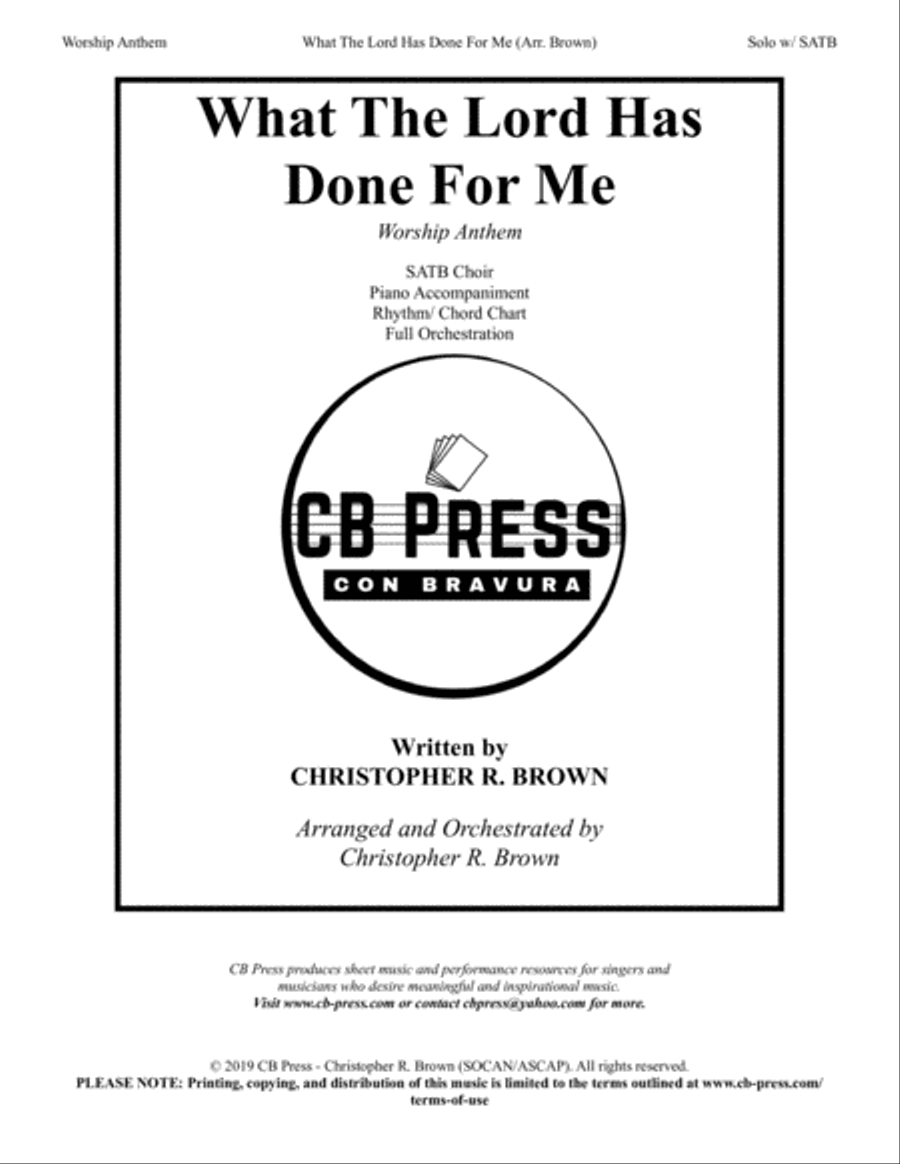Full Orchestra - Level 3 - Digital Download SKU: A0.747214 Composed by Christopher R. Brown. Christian,Gospel,Praise & Worship,Sacred. Score and parts. 83 pages. Christopher Brown #4756795. Published by Christopher Brown (A0.747214). About the song: In Psalm 22:22, David writes, I will praise You to all my brothers; I will stand up before the congregation and testify to the wonderful things You have done. Again, in Psalm 66:16, the psalmist says, Come and listen, all you who fear God, and I will tell you what He did for me. Jesus, after healing a man with a demon, commands the man to go home... and report the great things the Lord has done for you, and how He had mercy on you. The testimony of a life changed by God's love and His great mercy is a powerful tool for both spreading the Good News and resisting temptation. It is good for us to remember and proclaim, both personally and collectively, the great things the Lord has done.Can be performed with piano accompaniment only, OR with additional band members (rhythm chart included), OR with full orchestra.Please Note:You can purchase individual copies of the choral score separately on Sheet Music Plus. Performance of this piece requires the purchase of one choral score per singer.Included in your Purchase:Full ScoreChoral Score (SATB with Solo)Piano AccompanimentRhythm ChartDrumsetFlute 1, 2Oboe (opt. Soprano Sax doubles)Clarinet 1, 2Horn 1, 2 (opt. Alto Sax doubles)Trumpet 1, 2Trumpet 3Trombone 1, 2 (opt. Tenor Sax doubles)Trombone 3/ Tuba (opt. Bari Sax doubles)Percussion 1, 2HarpViolin 1, 2ViolaCelloString Bass (opt. Bass Clarinet/ Bassoon doubles)Lyrics:Verse 1Let me tell you a story of grace,How the Son of Man died in my place.Raised to life, all my sin was erased.Praise the Name of the Lord.Verse 2Many times I have asked of the Lord,On my knees I have prayed and implored.In the waiting my soul is restored,Praise the Name of the Lord.Chorus 1This is what the Lord has done for me,Paid my debt and set this captive free.Mercy flowed down at Calvary,This is what the Lord has done for me.Verse 3When I’m tempted to fear the unknown,I’m reminded I don’t walk alone.Christ is with me and He’ll lead me home,Praise the Name of the Lord.Chorus 2This is what the Lord has done for me,Paid my debt and set this captive free.Mercy flowed down at Calvary,This is what the Lord has done for me.BridgeOpened these blind eyes to see,Softened this heart to believe,Pardoned my sin on a tree,Now I stand redeemed.Key Change (up whole tone)Chorus 3This is what the Lord has done for me,Paid my debt and set this captive free.Mercy flowed down at Calvary,This is what the Lord has done for me.Chorus 4This is what the Lord has done for me,Paid my debt and set this captive free.Mercy flowed down at Calvary,This is what the Lord has done for me.This is what the Lord has done for me.
